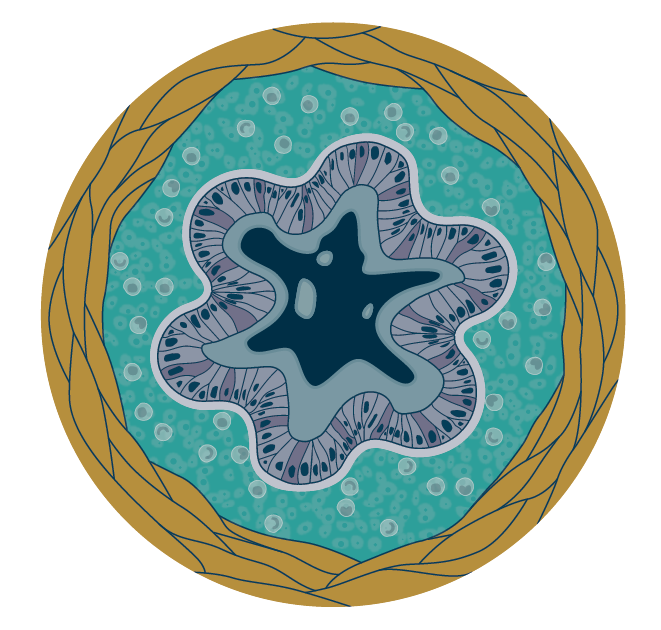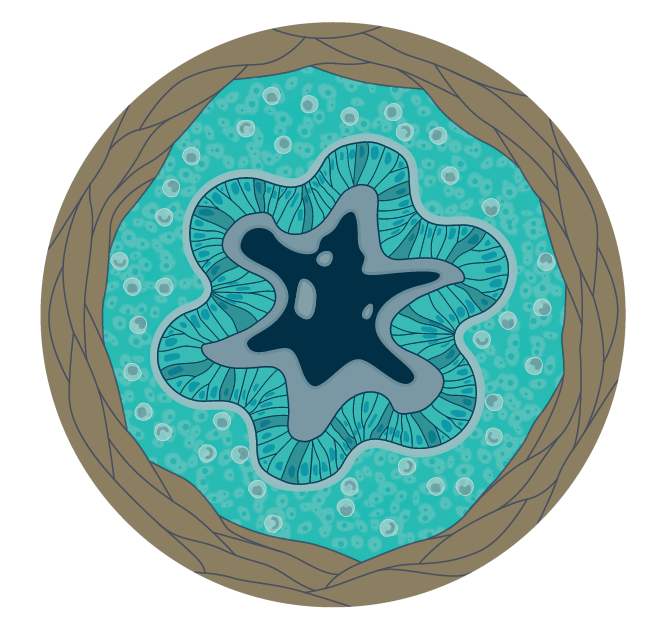RISING EVIDENCE
for treatment of asthma symptoms and inflammation with rescue
SABA
Short-acting β2-agonist
Relaxes airway
smooth muscle,
promoting
bronchodilation1



BRONCHIAL AIRWAY CROSS SECTION4
FOR ILLUSTRATIVE PURPOSES ONLY
Adapted from Bossé Y, et al. Annu Rev Physiol. 2010;72:437-462.
ICS
Inhaled corticosteroid
Suppresses
the inflammatory response
and amplifies
bronchodilation2,3



BRONCHIAL AIRWAY CROSS SECTION4
FOR ILLUSTRATIVE PURPOSES ONLY
Adapted from Bossé Y, et al. Annu Rev Physiol. 2010;72:437-462.
A broad clinical program exploring as-needed treatment for asthma
FEATURED RESEARCH
MANDALA
3040 patients5-8
Short-acting β2-agonist (SABA)
Study Design
Population
Efficacy
Safety
Experts from around the world support a rescue approach that aims to treat symptoms and inflammation concomitantly9,10
Explore further research assessing the impact of SABA/ICS treatment on lung function
DENALI
989 patients5,6,11,12
Results support a paradigm shift in as-needed treatments for asthma7,8,11
Additional Resources and Learning
You are about to leave
airsuprahcp.com
AstraZeneca does not control, review, or endorse third-party content and is not responsible for the content you are about to access. We provide links to external websites as a convenience and for educational purposes only.

You are about to leave
airsuprahcp.com
This link will take you to a site where you will be able to learn more

You are about to leave
airsuprahcp.com
This link will take you to a site where you will be able to learn more

Study Design
Randomized, double-blind, multicenter, variable-length exacerbation study (≥24 weeks duration) that evaluated the efficacy and safety of as-needed albuterol-budesonide compared to albuterol in symptomatic patients ≥12 years old with moderate to severe asthma and a history of ≥1 prior-year exacerbation (N = 3040)5-8
TREATMENT ARMSa,b
- Albuterol–budesonide 180/160 mcg as-neededb
n = 1013 - Albuterol-budesonide 180/80 mcg as-neededb
n = 1013
Dosing regimen not approved in the US - Albuterol 180 mcg as-neededb
n = 1014 - Trial Duration: Until at least 570 events recordedc
PRIMARY ENDPOINT
Time to first severe asthma exacerbationd
SECONDARY ENDPOINTS
Annualized rate of severe exacerbations
Annualized total SCS dose
Response in ACQ-5 and AQLQ+12 at Week 24
- NOTE: While patients 12 to 17 years were included in these trials, AIRSUPRA is not approved in this age group; therefore, efficacy results are presented for patients with asthma 18 years of age and older.
- an values reflect number of patients randomized, but not necessarily the number treated or the number included in safety/efficacy analyses.
- bDoses consisted of two inhaler actuations, with each actuation delivering albuterol-budesonide 90/80 mcg for the 180/160 mcg arm, albuterol-budesonide 90/40 mcg for the 180/80 mcg arm, and albuterol 90 mcg for the albuterol-alone arm.
- cTreatment period was event-driven and continued until ≥570 first severe exacerbation events were recorded and 3000 adults and adolescents were randomized and completed ≥24 weeks of treatment.
- dDefined as worsening or onset of asthma symptoms that required systemic corticosteroids for ≥3 days or an emergency room visit that led to the use of systemic corticosteroids for ≥3 days or a hospitalization for ≥24 hours due to asthma.
- ACQ, Asthma Control Questionnaire; AQLQ+12, Asthma Quality of Life Questionnaire validated for persons ≥12 years of age; SCS, systemic corticosteroids.
Patient Population
STUDY ELIGIBILITY5,8
KEY INCLUSION CRITERIA
- Symptomatic patients with moderate to
severe asthma - At least 1 year since asthma diagnosis
- ≥1 severe asthma exacerbation in previous year
- Asthma maintenance therapya for ≥3 months, with stable dosing for ≥4 weeks prior to screening
- Pre-bronchodilator FEV1 ≥40% to <90% of predicted normal (for patients aged 12 to
<18 years old, ≥60%) and a confirmed reversibility to albuterol
KEY EXCLUSION CRITERIA
- COPD or other significant lung disease
- SCS use within 6 weeks prior to screening
- Chronic OCS use (≥3 weeks within
3 months prior to screening) - Biologic treatment within 3 months or
5 half-lives of screening - Pregnancy (active or planned)
or breastfeeding
- NOTE: While patients 12 to 17 years were included in these trials, AIRSUPRA is not approved in this age group; therefore, efficacy results are presented for patients with asthma 18 years
of age and older. - aMedium to high-dose ICS or low to high-dose ICS-LABA with or without an additional controller.
- COPD, chronic obstructive pulmonary disease; FEV1, forced expiratory volume in 1 second; ICS, inhaled corticosteroid; LABA, long-acting β2-agonist; OCS, oral corticosteroid;
SCS, systemic corticosteroid.
Patient Population
TOTAL N: 2940 (RANDOMIZED)5,6
KEY DEMOGRAPHICS
- Mean age: 52 years (range: 18-84 years)
-
Gender
34%Male66%Female -
Race
82%Caucasian18%Other -
Ethnicity
25%Hispanic or Latino75%Not Hispanic or Latino
KEY CLINICAL PARAMETERS
- Mean prebronchodilator % predicted FEV1: 62.9±12.6a
- Mean % reversibility in FEV1: 27.6±15.1b
-
Severe exacerbations, prior 12 months:
80%120%>1 -
Background maintenance treatment for
moderate-to-severe asthma (as defined by GINA)9,c30%Low-dose ICS–LABA
or medium-dose ICSd40%Medium-dose ICS–LABA
or high-dose ICSd28%High-dose
ICS–LABAdMissing data: 2%
- NOTE: While patients 12 to 17 years were included in these trials, AIRSUPRA is not approved in this age group; therefore, efficacy results are presented for patients with asthma 18 years
of age and older. - an=2938.
- bn=2937.
- cPatients continued to receive their maintenance medications during the study.
- dTaken with or without LTRA, LAMA, or theophylline.
- FEV1, forced expiratory volume in 1 second; GINA, Global Initiative for Asthma; ICS, inhaled corticosteroid; LABA, long-acting β2-agonist; LAMA, long-acting muscarinic antagonists;
LTRA, leukotriene receptor antagonists.
Efficacy
PRIMARY ENDPOINT: TIME TO FIRST SEVERE ASTHMA EXACERBATION5,7
As-needed albuterol-budesonide 180/160 mcg significantly reduced
the risk of a severe exacerbation versus albuterola,b
Albuterol–budesonide 180/160 mcgc vs
albuterol 180 mcg alone
28%
REDUCTION
IN RISK
HR 0.72
(95% CI: 0.60, 0.86)
p<0.001
- NOTE: While patients 12 to 17 years were included in these trials, AIRSUPRA is not approved in this age group; therefore, efficacy results are presented for patients with asthma 18 years of age and older.
- aData shown are from the pre-planned on-treatment efficacy analysis, which included data collected during the on-treatment period prior to treatment discontinuation or change in maintenance therapy.
- bAn asthma exacerbation was considered severe if it resulted in at least 1 of the following: a temporary bolus/burst of SCS for at least 3 consecutive days to treat symptoms of asthma worsening (a single depo-injectable dose of corticosteroids was considered equivalent), an emergency room or urgent care visit due to asthma that required SCS, or an in-patient hospitalization due to asthma.
- cType 1 error was controlled for comparison of albuterol-budesonide 180/160 mcg dose with albuterol alone with the Hochburg procedure.
- CI, confidence interval; HR, hazard ratio; SCS, systemic corticosteroids.
Efficacy
As-needed
albuterol-budesonide 180/160 mcg
vs
albuterol alonea
KEY SECONDARY ENDPOINTS5,7
SEVERE
EXACERBATION RATE
(Annualized RR)
SYSTEMIC CORTICOSTEROIDSc
(Reduction in mean annualized dose)
RESPONDER ANALYSIS AT WEEK 24d,e,f
(ACQ-5 OR)
0.76b
(95% CI: 0.62, 0.93)
p=0.008
31.5%
Reduction
1.21
(95% CI: 1.01, 1.46)
- NOTE: While patients 12 to 17 years were included in these trials, AIRSUPRA is not approved in this age group; therefore, efficacy results are presented for patients with asthma 18 years
of age and older. - aData shown are from the pre-planned on-treatment efficacy analysis, which included data collected during the on-treatment period prior to treatment discontinuation or change in maintenance therapy.
- bAnnualized rates of severe exacerbations for albuterol-budesonide 180/160 mcg and albuterol 180 mcg are 0.46 and 0.60, respectively.
- cFor patients treated with albuterol-budesonide 180/160 mcg the annualized total SCS dose when compared with albuterol 180 mcg was statistically significantly different, with a reduction in mean annualized dose of 40 mg per patient [albuterol-budesonide 180/160 mcg (87 mg) vs albuterol 180 mcg (127 mg)].
- dDefined as a decrease in the ACQ-5 score of at least 0.5 points from the baseline score.
- eThe percentage of ACQ-5 adult responders at Week 24 for albuterol-budesonide 180/160 mcg was 67% compared with 63% for albuterol.
- fThe percentage of AQLQ+12 adult responders at Week 24 (not shown) for albuterol-budesonide 180/160 mcg was 52% compared to 47% with albuterol 180 mcg (OR 1.22; 95% CI: 1.01, 1.47).
- ACQ, Asthma Control Questionnaire; AQLQ+12, Asthma Quality of Life Questionnaire validated for persons ≥12 years of age; CI, confidence interval; OR, odds ratio; RR, rate ratio; SD, standard deviation; SCS, systemic corticosteroids.
Safety
SUMMARY OF ADVERSE REACTIONS WITH
ALBUTEROL-BUDESONIDE REPORTED IN ≥1% OF PATIENTS5
Headache
Oral candidiasisa
Cough
Albuterol–budesonide
180/160 mcg
n = 1015
n (%)
Albuterol
180 mcg
n = 1015
n (%)
44 (4.3)
50 (4.9)
13 (1.3)
5 (0.5)
10 (1.0)
11 (1.1)
The safety profile of AIRSUPRA in MANDALA was similar across
the 2 treatment groups irrespective of background ICS dose
- NOTE: Data shown for albuterol-budesonide 180/160 mcg and albuterol 180 mcg are for patients ≥12 years old. AIRSUPRA is not approved for patients 12 to 17 years of age.
- aOral candidiasis also includes those reactions reported under the preferred term oropharyngeal candidiasis.
- ICS, inhaled corticosteroid.
DENALI
- STUDY SUMMARY
- EFFICACY
- SAFETY
DENALI was a double-blind, active-comparator and placebo-controlled lung function study conducted over 12 weeks that evaluated the efficacy and safety of albuterol-budesonide in patients ≥12 years old with mild to moderate asthma5,6,11,12,a
- Albuterol-budesonide 180/160 mcg QIDb
n = 197 - Albuterol-budesonide 180/80 mcg QIDb
n = 201
Dosing regimen not approved in the US - Budesonide 160 mcg QIDb
n = 199 - Albuterol 180 mcg QIDb
n = 196 - Placebo QIDb
n = 196 - Trial Duration: 12 weeks
- NOTE: While patients 12 to 17 years were included in these trials, AIRSUPRA is not approved in this age group; therefore, efficacy results are presented for patients with asthma 18 years of age and older. Since albuterol-budesonide 180/80 mcg is not an approved dose, results will not be presented for this arm of the study. AIRSUPRA is indicated for the as-needed treatment or prevention of bronchoconstriction and to reduce the risk of exacerbations in patients with asthma ≥18 years of age and is not indicated or approved for maintenance use.
- aPatients (N=989) were previously treated with as-needed SABA alone or low-dose maintenance ICS plus as-needed SABA.
- bDoses consisted of two inhaler actuations, with each actuation delivering albuterol-budesonide 90/80 mcg for the 180/160 mcg arm, albuterol-budesonide 90/40 mcg for the 180/80 mcg arm, budesonide 80 mcg for the budesonide-alone arm, and albuterol 90 mcg for the albuterol-alone arm.
- ICS, inhaled corticosteroid; QID, four times a day; SABA, short-acting β2-agonist.
DENALI
- STUDY SUMMARY
- EFFICACY
- SAFETY
The profiles of albuterol-budesonide 180/160 mcg and albuterol were similar in terms of FEV1 response, including time to onset and duration of effect5
Patients with observed onset of bronchodilationa
Median time
to onsetb
Mean duration of bronchodilationb
Albuterol-budesonide
180/160 mcg
Albuterol
180 mcg
51%
43%
7.5
MINUTES
10
MINUTES
186.9
MINUTES
167.9
MINUTES
- NOTE: While patients 12 to 17 years were included in these trials, AIRSUPRA is not approved in this age group; therefore, efficacy results are presented for patients with asthma 18 years of age and older.
- aAs defined by a ≥15% increase in FEV1 post-dose within 30 minutes on Day 1.
- bFollowing a single dose on Day 1.
- FEV1, forced expiratory volume in 1 second.
DENALI
- STUDY SUMMARY
- EFFICACY
- SAFETY
The adverse reactions profile was similar to MANDALA with some exceptions5,6
ADVERSE REACTIONS FOR ALBUTEROL-BUDESONIDE WITH AN INCIDENCE
OF ≥1% THAT EXCEEDED THE INCIDENCE IN MANDALA
Headache
Dysphonia
Oral/oropharyngeal candidiasis
Albuterol-budesonide
180/160 mcg
n = 197
n (%)
Placebo
n = 196
n (%)
10 (5.1)
14 (7.1)
4 (2.0)
0
3 (1.5)
0
- NOTE: Data shown for albuterol-budesonide 180/160 mcg and placebo are for patients ≥12 years old. AIRSUPRA is not approved for patients 12 to 17 years of age.